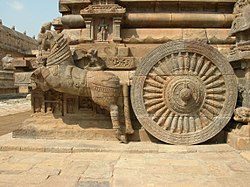History of the horse in the Indian subcontinent
Appearance

The horse has been present in the Indian subcontinent from at least the middle of the second millennium BC, more than two millennia after its domestication in Central Asia.
Quotes
[edit]- The four and thirty ribs of the strong steed,
Kin of the gods, the axe meeteth;
Skilfully do ye make the joints faultless;
Declaring each part, do ye cut it asunder.- Yajurveda, iv, 6, 9b, translated by Arthur Berriedale Keith (1914)
- The birthplace of the horse, indeed, is the sea, its kindred is the sea.
- Yajurveda, vii, 5, 25, translated by Arthur Berriedale Keith (1914)
- See also: E. F. Bryant, The Quest for the Origins of Vedic Culture (Oxford University Press, 2001), ch. 9
- Horses had she of noblest breed,
Like Indra's for their form and speed,
From Váhlí's hills and Sindhu's sand,
Vanáyu and Kámboja's land.- Ramayana, i, 6, translated by Ralph T. H. Griffith (1870–4)
- Like youthful elephants, tall and strong,
Fleet coursers whirled the car along:
In such a car the Thousand-eyed
Borne by swift horses loves to ride.- Ramayana, ii, 16, translated by Ralph T. H. Griffith (1870–4)
- Let couriers to thy father speed
On horses of the swiftest breed.- Ramayana, ii, 19, translated by Ralph T. H. Griffith (1870–4)
- Why does no gold-wrought chariot lead
With four brave horses, best for speed?- Ramayana, ii, 26, translated by Ralph T. H. Griffith (1870–4)
- Scarce could I move each stubborn horse:
Shedding hot tears of grief he stood
When Ráma turned him to the wood.
- Śatrughna, look, the mountain see
Where heavenly minstrels wander free,
And horses browse beneath the steep,
Countless as monsters in the deep.- Ramayana, ii, 93, translated by Ralph T. H. Griffith (1870–4)
- And thought-swift horses whirled their lord
Racing along the earth, or rose
High through the clouds whene'er he chose.- Ramayana, v, 47, translated by Ralph T. H. Griffith (1870–4)

